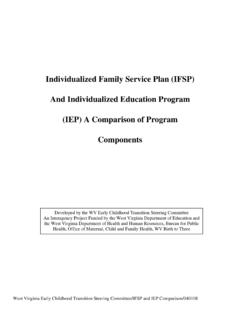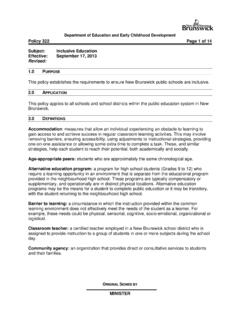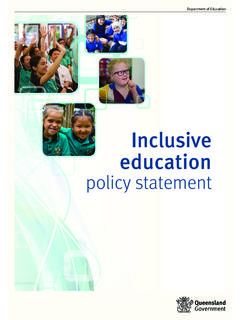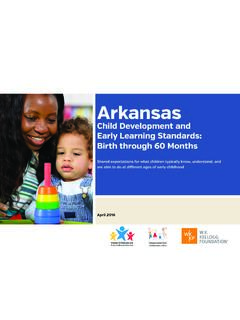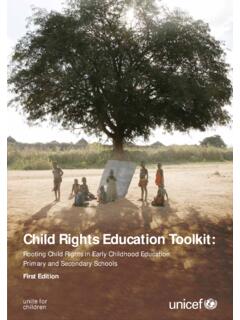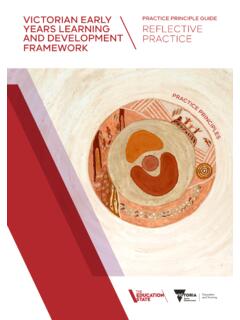Transcription of Early Learning Standards Framework Guidebook
1 Early Learning Standards Framework Guidebook 3rd Edition WVBE Policy Effective August 10, 2015. West Virginia Board of education 2015-2016. Michael I. Green, President Lloyd G. Jackson II, Vice President Tina H. Combs, Secretary Thomas W. Campbell, Member Beverly E. Kingery, Member L. Wade Linger, Jr., Member Gayle C. Manchin, Member William M. White, Member James S. Wilson, Member Paul L. Hill, Ex Officio Chancellor West Virginia Higher education Policy Commission Sarah A. Tucker, Ex Officio Interim Chancellor West Virginia Community and Technical College education Michael J. Martirano, Ex Officio State Superintendent of Schools West Virginia Department of education Table of Contents Foundations of the Early Learning Standards Framework Explanation of 6. How to Read the 6. Social and Emotional 8. English Language 13.
2 The Health and Physical Approaches to 20. Connecting the WV Early Learning Standards Framework to 1. 2. Early Learning Standards Framework Introduction Children benefit from high quality preschool experiences that are grounded in Standards -based practices. The West Virginia Early Learning Standards provide a Framework across all Learning domains. Enriched environments and optimized Learning opportunities to support the West Virginia Early Learning Standards Framework (hereinafter WV ELSF) take place in a variety of Early Learning settings. In March 2002, the West Virginia legislature passed Senate Bill 247 that became West Virginia Code 18-5-44, a mandate for high quality Early education programs for all four-year-old children and three year old children with identified special needs. These Early education programs are known as West Virginia Pre K (hereinafter WV Pre-K).
3 To support the provision of enriched environments for young children, a collaborative group of West Virginia Early education professionals developed the WV ELSF. The Standards are designed to serve as Early Learning guidelines for all children ages three through five regardless of the setting. The WV ELSF is grounded in scientific child development research, children's approaches to Learning , and effective educational practices. Vital to implementing these Standards is the ability to teach using appropriate strategies. Teaching practices grounded in the implementation of these Standards will create a foundation of lifelong Learning for West Virginia's children. Young children live in a society where information is constantly changing and the ability to function well in an increasingly global economy is essential.
4 As a result, it is essential that children develop dispositions and skills which allow them to become competent, independent learners who utilize the world around them to progress across all developmental domains. To fulfill this role, teachers of young children must also be lifelong learners, continuously building their professional knowledge and functional competencies based on current research. The WV ELSF is intended to guide practitioners in offering high-quality Early education environments and experiences that are responsive to individual children and maximize Learning . Using this Framework , educators can plan high-quality Learning experiences for all children, including those with disabilities. The Framework is not designed as an assessment tool, nor should it be used as a way to delay the entry of eligible children into kindergarten.
5 The WV ELSF is considered an integral part of an inter related comprehensive curriculum and assessment system as defined by West Virginia Board of education Policy 2525, West Virginia's Universal Access to A Quality Early education . The West Virginia Board of education has the responsibility for establishing high quality Standards for all education programs (W. Va. Code 18-9A- 22). Several foundations frame the design of the WV ELSF and describe an approach that promotes lifelong Learning competencies. 3. Foundations of the Early Learning Standards Framework Chart Foundations Description Representation and symbolic Children use representation and symbolic thinking across all domains to thinking are critical. develop understandings of concepts and generalizations from concrete to abstract. The ability to pretend and use symbols are foundations of symbolic and abstract thought, which leads to the development of academic skills such as math, science, and literacy.
6 The experiences that lead to a child's ability to think abstractly must be embedded in the curriculum through opportunities for active exploration, pretend play, and symbolic communication. Children should have the opportunity to invent with materials and words. Children are active learners. Children learn through active involvement (exploring, playing, manipulating, and problem-solving). They construct their own knowledge by engaging in experiences in the environment with peers and adults. Adults must use experiences with children to scaffold previous knowledge with new concepts. Active Learning is a key component of both child-initiated and teacher- facilitated experiences. Development and Learning are Learning and development do not simply coexist. The process of Learning is interrelated. directly related to the process of development.
7 Experiences grounded in the WV ELSF must be integrated and emphasize development and Learning . Each child is an individual Children go through similar stages of development but at individual rates. All learner. children within an age group should not be expected to arrive at Early Learning expectations at the same time or with the same degree of proficiency. Children with special needs Children with special needs must be offered a least restrictive environment are typically best served in that provides them opportunities to develop across domains through inclusive settings. interactions with their peers and adults. Attention to individual variation is critical, specifically regarding the development of concepts and proficiencies across domains. Individualized modifications and adaptations provide each child with opportunities to reach their full potential.
8 English Language Learners When immersed in an inclusive environment, children who are acquiring are best served in inclusive the English language are provided opportunities to develop expressive and settings. receptive language through interactions with their peers and adults. Attention to individual variation is critical, specifically regarding their development of concepts and proficiencies across domains. Children should be provided consistent opportunities to interact and demonstrate their abilities, skills, and knowledge in any language, including their home language. Family engagement is critical The family is the child's first and most important teacher. They provide a deep to the success of young understanding of their child as they enter and develop during their first years children. of school.
9 Teachers must establish and maintain ongoing relationships with families to best support children's development and linkages between home and school. 4. Foundations Description Children learn by Children begin their understanding of others by first interacting within their experiencing the culture and own families, neighborhoods, and schools. Early Learning settings and world in which they live. programs must be intentionally designed to provide children the opportunity to move from self-awareness to awareness and understanding of others. Using children's background knowledge as a catalyst for deepening understanding provides opportunities for children to experience and share various cultural aspects of the world in which they live. Each child's home culture and language are brought into the classroom as part of this shared classroom community.
10 Intentional teaching strategies must focus on acceptance and respect of all individuals. The environment is the child's Along with the family and the teacher, high-quality Early Learning environments third teacher. provide children with the tools necessary for continual growth and development. Learning environments should be designed and equipped in a manner that supports discovery, small group and individual Learning , exploration, problem solving, and development. The Learning environment should be designed to help children develop a sense of community. To achieve this, teachers must know the children and families well so they can plan intentional ways for everyone to interact and work collaboratively. School Readiness supports School readiness is a process of ensuring that children have access to the the holistic development of best available resources prior to entering first grade.

